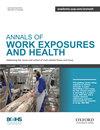185 The influence of measurement uncertainty and environmental factors in the assessment of workplace exposure
IF 1.8
4区 医学
Q3 PUBLIC, ENVIRONMENTAL & OCCUPATIONAL HEALTH
引用次数: 0
Abstract
According to good occupational hygiene practices, measurement uncertainty (U) should be included when testing TWA workplace atmosphere measurement against OEL. In some countries such as the US (OSHA) and Belgium, this is included in legislation: law enforcement tests the TWA lower confidence limit LCL=TWA*(1-U) exceedance of the OEL while employers test the TWA upper confidence limit UCL=TWA*(1+U) compliance with the OEL. International standards such as EN482 and ISO-20581 help establish U, UCL and LCL. Current exposure assessment strategies promoted by IOHA members, such as AIHA (2015), EN689 (2018) and BOSH/NVvA (2022), ignore measurement uncertainty. This may be due to historical work (Nicas, 1991), which shows that in similar exposure groups (SEG), lognormal long-term daily environmental variability exceeds U. However, Monte-Carlo simulations, which will be shown in this lecture, show that the influence of U on the lognormal, one-sided upper confidence limit of the 95th percentile (UTL95,##%) can be significant in occupational hygiene practice with sample sizes often smaller than n=6. Also in the last decade, several strategies promote a simplified screening/preliminary test (French Code du Travail, EN689:2018 §5.5.2, BOSH/NVvA 2011/2022). In these tests, the highest result (TWAmax) of 3 to 5 measurements is compared with the OEL or with a defined fraction f(OEL). In line with the above, these TWAmax tests should use TWAmax*(1-U) ≤ f(OEL) for compliance and TWAmax*(1+U) > OEL for exceedance. IOHA member organisations are advised not only to align the numerical test schedules for compliance, but also to include measurement uncertainty in the OEL tests.185 测量不确定性和环境因素对工作场所暴露评估的影响
根据良好的职业卫生规范,在根据 OEL 测试 TWA 工作场所大气测量值时,应将测量不确定性 (U) 包括在内。在美国(职业安全与健康管理局)和比利时等一些国家,这已纳入立法:执法部门测试 TWA 置信度下限 LCL=TWA*(1-U) 是否超过 OEL,而雇主则测试 TWA 置信度上限 UCL=TWA*(1+U) 是否符合 OEL。EN482 和 ISO-20581 等国际标准有助于确定 U、UCL 和 LCL。目前由 IOHA 成员推广的暴露评估策略,如 AIHA (2015)、EN689 (2018) 和 BOSH/NVvA (2022),忽略了测量的不确定性。这可能是由于历史工作(Nicas,1991 年)显示,在类似暴露组(SEG)中,对数正态长期日环境变异性超过了 U。然而,蒙特卡洛模拟(将在本讲座中展示)显示,在样本量通常小于 n=6 的职业卫生实践中,U 对对数正态、单侧置信上限第 95 百分位数(UTL95,##%)的影响可能很大。同样在过去十年中,有几项战略提倡简化筛查/初步检测(《法国劳动法典》、EN689:2018 第 5.5.2 节、BOSH/NVvA 2011/2022)。在这些测试中,将 3 至 5 次测量的最高结果(TWAmax)与 OEL 或定义的分数 f(OEL)进行比较。根据上述规定,这些 TWAmax 测试应使用 TWAmax*(1-U) ≤ f(OEL) 表示符合标准,使用 TWAmax*(1+U) > OEL 表示超标。建议 IOHA 成员组织不仅要调整符合性数值测试时间表,还要将测量不确定性纳入 OEL 测试。
本文章由计算机程序翻译,如有差异,请以英文原文为准。
求助全文
约1分钟内获得全文
求助全文
来源期刊

Annals Of Work Exposures and Health
Medicine-Public Health, Environmental and Occupational Health
CiteScore
4.60
自引率
19.20%
发文量
79
期刊介绍:
About the Journal
Annals of Work Exposures and Health is dedicated to presenting advances in exposure science supporting the recognition, quantification, and control of exposures at work, and epidemiological studies on their effects on human health and well-being. A key question we apply to submission is, "Is this paper going to help readers better understand, quantify, and control conditions at work that adversely or positively affect health and well-being?"
We are interested in high quality scientific research addressing:
the quantification of work exposures, including chemical, biological, physical, biomechanical, and psychosocial, and the elements of work organization giving rise to such exposures;
the relationship between these exposures and the acute and chronic health consequences for those exposed and their families and communities;
populations at special risk of work-related exposures including women, under-represented minorities, immigrants, and other vulnerable groups such as temporary, contingent and informal sector workers;
the effectiveness of interventions addressing exposure and risk including production technologies, work process engineering, and personal protective systems;
policies and management approaches to reduce risk and improve health and well-being among workers, their families or communities;
methodologies and mechanisms that underlie the quantification and/or control of exposure and risk.
There is heavy pressure on space in the journal, and the above interests mean that we do not usually publish papers that simply report local conditions without generalizable results. We are also unlikely to publish reports on human health and well-being without information on the work exposure characteristics giving rise to the effects. We particularly welcome contributions from scientists based in, or addressing conditions in, developing economies that fall within the above scope.
 求助内容:
求助内容: 应助结果提醒方式:
应助结果提醒方式:


